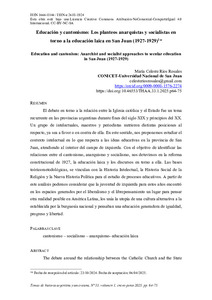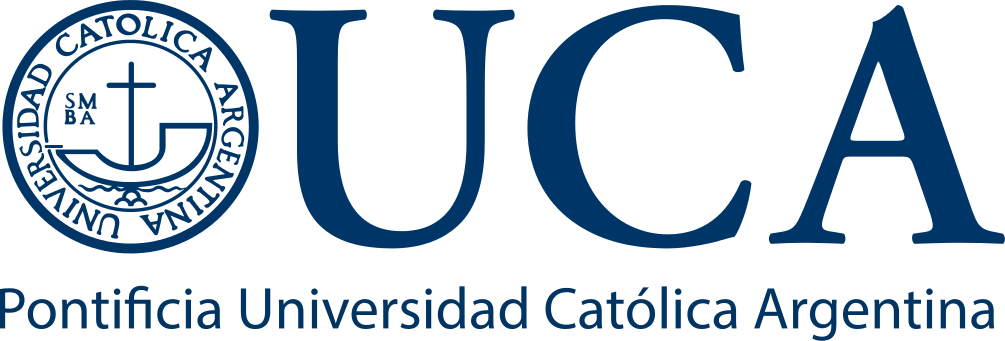Por favor, use este identificador para citar o enlazar este ítem:
https://repositorio.uca.edu.ar/handle/123456789/20167| Campo DC | Valor | Lengua/Idioma |
|---|---|---|
| dc.contributor.author | Ríos Rosales, María Celeste | es |
| dc.date.accessioned | 2025-07-15T17:51:53Z | - |
| dc.date.available | 2025-07-15T17:51:53Z | - |
| dc.date.issued | 2025 | - |
| dc.identifier.issn | 2618-1924 | - |
| dc.identifier.issn | 1666-8146 | - |
| dc.identifier.uri | https://repositorio.uca.edu.ar/handle/123456789/20167 | - |
| dc.description.abstract | El debate en torno a la relación entre la Iglesia católica y el Estado fue un tema recurrente en las provincias argentinas durante fines del siglo XIX y principios del XX. Un grupo de intelectuales, maestros y periodistas nutrieron distintas posiciones al respecto, ya sea a favor o en contra de ella. En este sentido, nos proponemos estudiar el contexto intelectual en lo que respecta a las ideas educativas en la provincia de San Juan, atendiendo al interior del campo de izquierda. Con el objetivo de identificar las relaciones entre el cantonismo, anarquismo y socialismo, nos detuvimos en la reforma constitucional de 1927, la educación laica y los discursos en torno a ella. Las bases teóricometodológicas, se vinculan con la Historia Intelectual, la Historia Social de la Religión y la Nueva Historia Política para el estudio de procesos educativos. A partir de este análisis podemos considerar que la juventud de izquierda para estos años encontró en los espacios generados por el liberalismo y el librepensamiento un lugar para pensar otra realidad posible en América Latina, los unía la utopía de una cultura alternativa a la establecida por la burguesía nacional y pensaban una educación generadora de igualdad, progreso y libertad. | es |
| dc.description.abstract | The debate around the relationship between the Catholic Church and the State was a recurring topic in the argentine provinces during the late 19th and early 20th centuries. A group of intellectuals, teachers and journalists nurtured different positions on the matter, either for or against it. In this sense, we propose to study the intellectual context in the province of San Juan, taking into account the interior of the left field. With the aim of identifying the relationships between cantonism, anarchism and socialism, stopping particularly at the educational reform of 1927, secular education and the discourses around it. The theoretical and methodological bases are linked to Intellectual History, Social History of Religion and New Political History for the study of educational processes. From this analysis we can consider that the left-wing youth in these years found in the spaces generated by liberalism and freethought a place to think about another possible reality in Latin America, they were united by the utopia of an alternative culture to that established by the national bourgeoisie and thought of an education that generated equality, progress and freedom. | es |
| dc.format | application/pdf | es |
| dc.language.iso | spa | es |
| dc.publisher | Pontificia Universidad Católica Argentina. Instituto de Historia Argentina y Americana | es |
| dc.rights | Atribución-NoComercial-CompartirIgual 4.0 Internacional | * |
| dc.rights.uri | http://creativecommons.org/licenses/by-nc-sa/4.0/ | * |
| dc.source | Temas de historia argentina y americana. 2025, 33(1) | es |
| dc.subject | SOCIALISMO | es |
| dc.subject | ANARQUISMO | es |
| dc.subject | EDUCACION LAICA | es |
| dc.title | Educación y cantonismo: los planteos anarquistas y socialistas en torno a la educación laica en San Juan (1927-1929) | es |
| dc.title | Education and cantonism: Anarchist and socialist approaches to secular education in San Juan (1927-1929) | es |
| dc.type | Artículo | es |
| dc.identifier.doi | 10.46553/THAA.33.1.2025.p64-75 | - |
| uca.issnrd | 1 | es |
| uca.affiliation | Fil: Ríos Rosales, María Celeste. Consejo Nacional de Investigaciones Científicas y Técnicas; Argentina | es |
| uca.version | publishedVersion | es |
| item.grantfulltext | open | - |
| item.fulltext | With Fulltext | - |
| item.languageiso639-1 | es | - |
| Aparece en las colecciones: | TEM - 2025 nro. 33 vol. 1 | |
Ficheros en este ítem:
| Fichero | Descripción | Tamaño | Formato | |
|---|---|---|---|---|
| educacion-cantonismo-planteos.pdf | 295,48 kB | Adobe PDF |  Visualizar/Abrir |
Este ítem está sujeto a una Licencia Creative Commons

